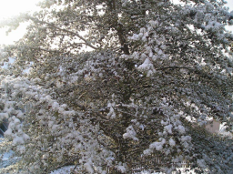Winter 2010
Table of Contents - Vol. VI, No. 4
Poetry Fiction NonFictionReviews
Todd Outcalt
The Spotting
This past spring-on a cool morning with coffee cup in hand-I spied the pileated
woodpecker through the dawn mist. Clinging to the trunk of the hackberry tree,
the bird was magnificent-long, lean, and crested with a flaming-red plume that
exploded against the earth-tone gray of the hackberry bark. Motionless, the
bird remained in its vertical hold for long minutes, a kind of snapshot, a
brush-stroke of color amid the ripe green leaves of spring. Suddenly, the bird
released and, instead of falling, rose majestically through a canopy of maple,
buckeye and oak until it disappeared against the morning sky.
The Deck Feeder
Another morning, days later, I am reunited with the woodpecker as it perches on
a rotting squirrel -feeder that the previous home owners had nailed to the
trunk of the hackberry. This is an odd picture, as I have never seen a pileated
searching for food in a feeder. But the bird pauses, as if studying the
situation, and then offers a few faint-hearted taps upon the rotted wood. There
are no grubs in the pores of the feeder and the bird's attention is suddenly
wrested away by a harsh gush of wind that stirs the leaves. As the bird wings
away, I stand at the window and wonder: where does the woodpecker find comfort,
and where does it go for solace from the storm?
The Siding
It is mid June. Striding along the path near the creek I hear the echo of a
rap-rap-rap on the side of the house. I locate a clear vista and peer up onto
the eastern face of our home. There, clinging to the house, is the pileated
woodpecker drilling its bill into my wood siding. Even from my distance, I can
see that the bird has culled a silver-dollar-sized hole in the pale
enamel-colored siding. I flinch at the thought, but am then suddenly moved by
the awe of the hunt. The giant crest of the pileated bobs and shudders as it
feeds on the miniscule. The waters of the creek slip silently along behind me
and, for a moment, my attention is wrested away by a small yellow dot of flower
that is peeking through the dirt along the hardened path where I am walking.
When I look up again, the woodpecker is gone.
The Silence
I consider the woodpecker one afternoon in early July while I am mowing the
yard. Days have passed without a sighting. Would anyone dare to assume a
woodpecker's joy?
The Return
Mid July, I am reunited with the pileated woodpecker. It clings, as before, to
the bark of the hackberry on a summer morning. As the bird angles its head away
from me, I can see that its beak is disproportionally long-a kind of curved
straw. The beak is the lifeblood of the pileated. The beak is its hope. With
wings flattened against its slender body, suddenly the woodpecker opens like a
trap door and, after a moment?s descent, rises like a breath on the summer air
and is gone.
The Last Sighting
As I amble up the lawn, firewood in hand, suddenly the woodpecker appears in a
clearing-a kind of spark, a flame flush against the verdant background of the
trees. Red against green, I cannot miss the bird as it steps, talon-prone, inch
by inch up the side of a towering sycamore. Weak-armed, I stoop to deposit the
firewood on the lawn and gaze up into the summer sky to study the bird again.
It is toying with me. Showing off as children do. Or so it seems. The pileated
shakes its plume at me-a wisp of blood-red feathers, fine as powder, and I can
see the ends dancing in the early August heat. The woodpecker pauses. We stare
at each other. Our meeting ends when the bird issues a guttural cry and sails
across the creek into a deep morass of maple and walnut.
The Death
Carrying the morning newspaper under my arm, I discover the pileated woodpecker
on the gravel driveway beneath the large bow window of my home office. It is
dead. Perhaps in early morning or the night before, it had flown-into the
reflection of the window and broken its neck. I kneel, set aside the newspaper,
and cusp the bird in my hands. It is still warm and pliable, like putty. I
marvel at the size of the bird, perhaps eighteen inches in length, and as the
morning light crosshatches the trees I note that the bird's feathers are a
myriad of color, a rainbow embedded in the darker navy-black of the body, and
the distinguishing red plume ripe with hints of white and yellow. The eyes are
closed, and the rims dotted with curious pustules of skin. The talons are coal
black, sharp as needles. I wrap the bird in a section of newspaper classifieds
and wonder how a woodpecker experiences its own color, its own existence? I
carry the bird down to the creek accompanied by the dirge of songbirds and the
rustling of mid-August leaves announcing the end of summer. I remove my shoes
and wade into the creek. The water is effervescent. I bend over and hold out
the section of newspaper containing the pileated woodpecker.
The Release
The hardest part is the letting go.
© Todd Outcalt
